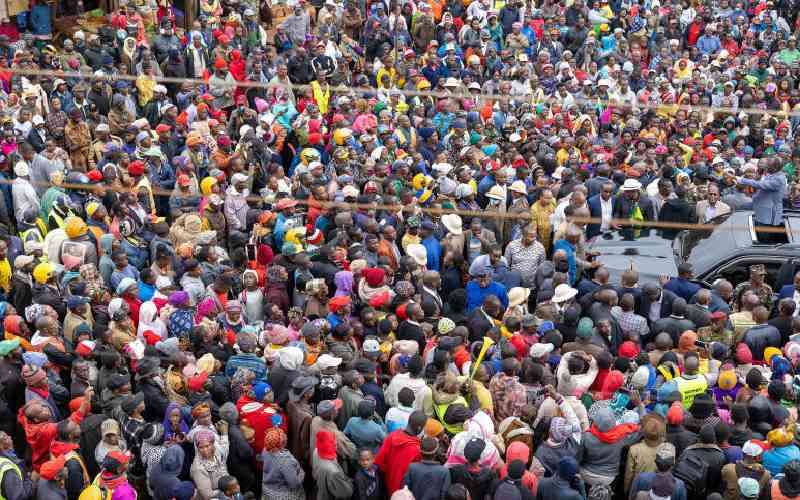By AMOS KAREITHI
When a naughty boy fouls the air in an assembly of elders, it is a waste of time looking for the real culprit. Any boy within the vicinity will do, and the more the merrier.
This was the principle applied by a 24-year old Kings African Rifle Colonel who carved administration boundaries with the bayonet of his rifle and forever engraved his name in Kenya’s history book in blood.
Richard Meinertzahen was a no-nonsense military officer who relocated from India to East Africa after he was tricked by his commanding officer to accompany him in a snipe shoot only to be dressed down for absconding duty.
 |
The busy Gakere Road in Nyeri town. The road is named after Ngunju wa Gakere who was arrested and later executed at Murang’a as a war criminal. He resisted Meinertzahen for three days and was only vanquished and captured after Nderi Wan’gombe and his lackeys combined forces with 200 Maasai spearmen from Nairobi, [PHOTOS: JOB WERU/STANDARD] |
On arrival in Nairobi from Mombasa on May 18, 1902, he was attached to the third battalion of KAR, where he was granted the command of No 8 company, comprising 125 Swahili, a few Sudanese and four Maasai serving alongside three other Europeans, Captain J D Mackay, Swire and Bailey.
Determined to leave his mark on Kenya on behalf of her majesty’s government, Meinertzahen, collected his first Kenyan artifacts, three human skulls of Maasai herdsmen who had died from the previous year’s (1901) famine.
His first tour of duty was Fort Hall, known as Murang’a; a name derived from the sound ng’a, made by the traditional cultivating implement, muro, when it encountered the unyielding barren rock.
Trouble was brewing in Murang’a, necessitating the Government to dispatch its enforcer, Meinertzahen with three non-commissioned soldiers, nine men, and 23 heavily laden porters on the four-day march.
Concubines in the barracks
Those were the days when KAR soldiers, described by historian John Lonsdale, in Modern History of Kenya, 1895-1980 as outcasts in their own communities were undisciplined and kept a string of concubines in their barracks.
Meinertzahen describes Murang’a (Fort Hall) town in his book, Kenya Diary, 1902-1906, as a collection of three grass houses, and a small bazaar where two Indian traders robbed locals of their produce in exchange of cheap beads and clothes.
Meinertzahen was a bundle of contradiction. He once executed five soldiers for allegedly shooting women and children long after a battle was over and had vowed he would never allow public fluffing of errant officers.
In Murang’a, trouble erupted on August 6, 1902, when the Government mail order was cut and six porters and policemen murdered.
The attack was staged near the present-day Thika town by a gang, which the Government believed hailed from Muruka location, near Kihumbuini.
Stay informed. Subscribe to our newsletter
In their haste, the attackers had not stolen the Government mailbag and had left some of their spears and arrows still lodged in their victims’ bodies.
Nature was in harmony with the locals for when the Government forces pitched their camp near Thika River they were attacked by lions, which mauled one soldier to death.
On return to Fort Hall, Meinertzahen found his command post under threat from the locals, who had planned to burn it.
"I told the villagers that if they attacked my camp, I would burn down every house in the village within five miles in 24 hours," he writes.
The soldier wryly acknowledges that this would have been a difficult task to accomplish as there were only three whites, and 70 soldiers and police officers he dismissively describes as niggers fighting against half a million locals.
He, however, got an opportunity to vent his anger on August 19, 1902, when irate villagers killed a police officer, who had attempted to publicly arrest a village headman.
"I surrounded the village on August 20, 1902 at 3am. I found the villagers performing an orgy around the mutilated body. We killed about 17 niggers. Two policemen and one of my men were killed," the soldier writes.
To drive his point home, Meinertzahen burnt all the houses, while two men incriminated with murder were sentenced to six months of hard labour. The medicine men, who had allegedly influenced them were imprisoned for one year.
Teach villagers a lesson
The attack was a dress rehearsal for Kihumbuini village in Muruka, which had been blacklisted after the Government’s mail caravan, was attacked. On September 17, 1902, reports reached Meinertzahen that a white settler had been attacked and killed.
"The terrible death they meted on one of my own countryman filled me with anger. I shall teach the offending village a lesson that will be long remembered by the Wakikuyu," the soldier vowed.
He was enraged by the mistreatment the settler who had allegedly gone to buy a sheep was pinned on the ground and allegedly turned into a public toilet as all villagers urinated in his mouth, drowning him.
After surrounding the village at night of September 18, 1902, Meinertzahen details how he dished out his punishment: "I gave orders that every living except children should be killed without mercy. Every soul was either shot or bayoneted. We burnt all the huts and razed the banana plantations to the ground."
Former Central Bank governor, Duncan Nderitu Ndegwa, in his book, Walking in Kenyatta Struggles: My Story asserts that Meinertzahen introduced jiggers and an Asian flu as a biological weapon.
The killing of the settler was just an excuse, Ndegwa claims for the total annihilation, which saw even women and children bayoneted while livestock were confiscated.
Maina Kinyatti in his book, Agikuyu, 1890-1965; Waiyaki, Kenyatta, Kimathi, says that after the attack in Kihumbuini, Meinertzahen and his forces then captured 170 head of cattle and 1,000 sheep.
While retreating from the village after waging three days of terror, the Government troops met a group of boys, with a huge flock of sheep, and duped them with sugared almonds to part with the sheep.
At around this period, the Government had imposed a hut tax of three Rupees or an equivalent of one sheep, leading to a rare development when the establishment could not cope with the tax.
At one point, the treasury’s vault in Murang’a comprised a sheep pen, which had so many sheep that the Government ordered the owners to collect their animals.
The worst atrocities were, however, reserved for architects of a rebellion, which was brewing in Tetu prejudged guilty for the November 24, 1902, attack on an Indian caravan.
Here, Meinertzahen rediscovered his ingenuity in evils as he invented a novelty, barbed wire enclosure that ensnared many warriors into his death trap.
Inevitably, Sub-Commissioner, S L Hinde government unleashed troops among them Meinertzahen, who arrived in Tetu with a force of 25 Maasai and 15 rifles, and felled 20 people on arrival.
On December 18, 1902, he duped the locals he had been evacuated from his camp, but hid inside with some soldiers and later opened fire on curious villagers who trooped in out of curiosity.
Camouflaged soldiers
He at one time erected a barbed wire fence, locally known as Thigingi, where curious villagers would visit, only to be welcomed by gunfire from the camouflaged soldiers.
Meinertzahen estimated he killed 1,500 people in Tetu alone, although the governor scaled it to 400, although historians are convinced the numbers were higher.
This was a war like no other for civilians, including the sub-commissioner’s wife; Mrs Hinde was allowed at the battlefront, to the chagrin of the mercurial colonel who demanded that civilians be chased away from, the war zone.
During the fighting one of the leaders, Ngunju wa Gakere, was arrested and later executed at Murang’a as a war criminal. His name is immortalised with the naming of one of Nyeri town’s road in his honour.
Gakere resisted Meinertzahen for three days and was only vanquished and captured after Nderi Wan’gombe and his lackeys combined forces with 200 Maasai spearmen from Nairobi to boost Government troops.
After the fierce battle near the present day Nyeri Golf Club during which hundreds of locals were decapitated, the resistance was broken and Wang’ombe later appointed a chief.
Later on December 18, 1902, hours after the massacre of 50 people in Thigingi, the war council comprising of Meinertzahen, Mackay and Hinde, made a resolution to stop the war. It was also decided that a station be established near the spot where residents had been massacred and be named Nyeri, which would later become the Central Provincial headquarters, the bastion of colonial authority.
And December 20, 1902, Ndegwa recounts in his book, "As the sun went down the Nyandarua mountains (Aberdare) the union jack also rose up a 30-foot pole amidst strange sounds from a bugle ending one era marking the beginning of decades of suppression and humiliation."
akareithi@standardmedia.co.ke
 The Standard Group Plc is a
multi-media organization with investments in media platforms spanning newspaper
print operations, television, radio broadcasting, digital and online services. The
Standard Group is recognized as a leading multi-media house in Kenya with a key
influence in matters of national and international interest.
The Standard Group Plc is a
multi-media organization with investments in media platforms spanning newspaper
print operations, television, radio broadcasting, digital and online services. The
Standard Group is recognized as a leading multi-media house in Kenya with a key
influence in matters of national and international interest.
 The Standard Group Plc is a
multi-media organization with investments in media platforms spanning newspaper
print operations, television, radio broadcasting, digital and online services. The
Standard Group is recognized as a leading multi-media house in Kenya with a key
influence in matters of national and international interest.
The Standard Group Plc is a
multi-media organization with investments in media platforms spanning newspaper
print operations, television, radio broadcasting, digital and online services. The
Standard Group is recognized as a leading multi-media house in Kenya with a key
influence in matters of national and international interest.






